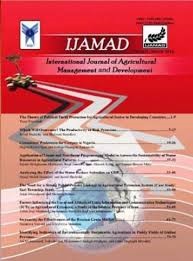-
-
List of Articles
-
Open Access Article
1 - The impacts of educational and extensional methods on using renewable energy by Semnan poultry farmers
Mohsen Mohammadi Mohammad Sabouri Seyed Sadjad Seyed Sabouri -
Open Access Article
2 - Exploring the strategy of Reducing Water Consumption Expenditure and its Role in Farmers' Satisfaction
mohammad ali dadashi Vahid Khasheii -
Open Access Article
3 - Comparison of healthy crop cultivation behavior based on demographic variables (Case study: rural beneficiaries Kermanshah province in Iran)
مرضیه معرف alireza poursaeed roya eshraghi hamed chaharsoghi amin -
Open Access Article
4 - Designing Marketing Strategies for Kiwifruit Export to International Markets Based on Grounded Theory and SWOT Method (A Case Study of Amin Caspian Shomal co.)
مهدیه مددخواه ابراهیم چیرانی مریم اوشک سرایی -
Open Access Article
5 - The Role of Production Factors in the Growth of Iranian Economy, with Emphasis on Natural Resources and Labor and Environmental Degradation
صمد زارعی سید نعمت اله موسوی -
Open Access Article
6 - business opportunities for rural areas in Ilam province
همایون مرادنژادی مرجان واحدی -
Open Access Article
7 - Designing a Model for Intelligent Management of Agri-Businesses Supply Chain
سحر اسدزاده منجیلی فیروزه حاجی علی اکبری نبی اله محمدی -
Open Access Article
8 - Life cycle of energy-economic analysis for different cultivation scenarios of paddy production (Case study: Khuzestan Province)
Mohammad Gholami Parashkoohi Heidar Molaee Jafrodi Hamed Afshari Davood Mohammad Zamani -
Open Access Article
9 - Modeling energy use and economic productivity of different fish production systems using artificial neural networks
محمد غلامی پرشکوهی محسن رسولی بابک بهشتی محمد قهدریجانی -
Open Access Article
10 - The comparison of algae production systems based on energy consumption and economic analysis: The application of data envelopment analysis
ناصر کاظمی محمد غلامی پرشکوهی احمد محمدی داود محمد زمانی -
Open Access Article
11 - Qualitative analysis and Prioritize the Challenges of Sustainable Agricultural Development through Grounded Theory and AHP in Iran
Keivan Torfi Ahmadreza Ommani Azadeh Noorollah Noorivandi mohammad sadegh sabouri -
Open Access Article
12 - Educational Program Based on the Health Action Process Approach and Its Effect on Integrated Pest Management Adoption in Greenhouse Farmers
رضا پورنارانی Mohammad Ali Morowatisharif Farzan Madadizadeh -
Open Access Article
13 - Investigating Challenges of agricultural knowledge and information systems (AKIS) in Iran with Delphi technique
سیده مرضیه رازقی Hasan Sadighi Mohammad Chizari
-
The rights to this website are owned by the Raimag Press Management System.
Copyright © 2021-2025







